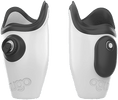
Why some 3D-printed definitive sockets can feel heavy—and why it’s hard to find the “right” patient
, Von Hugh Sheridan, 7 min Lesezeit

, Von Hugh Sheridan, 7 min Lesezeit
This article unpacks the engineering reasons that can drive weight up, explains selection pitfalls, and clarifies where products from Augo (Invent Medical), Instalimb, and Proteor’s Icarus-based workflows fit into the picture
3D printing is reshaping prosthetics, but clinics sometimes report that certain definitive (long-term) 3D-printed sockets feel heavy in daily use and that matching them to the ideal patient profile is tricky. This article unpacks the engineering reasons that can drive weight up, explains selection pitfalls, and clarifies where products from Augo (Invent Medical), Instalimb, and Proteor’s Icarus-based workflows fit into the picture—using public information and the peer-reviewed record.
a) Safety factors drive wall thickness
Definitive sockets must survive years of cyclic loading and out-of-plane impacts. In FDM/FFF and other polymer AM, inter-layer strength and fatigue are the limiting mechanisms; labs/designers compensate with thicker walls, denser shells, or reinforced zones, which raises mass. Systematic reviews note that while 3D-printed AFOs/sockets are feasible, mechanical test methods and fatigue data vary, pushing conservative design.
b) Material choice: durable ≠ ultralight by default
Widely used materials (e.g., PA12/nylon, sometimes with CF-reinforcement) give robust, clinic-friendly parts—but at a given stiffness target, solid polymer shells can outweigh laminated composites unless geometry is aggressively optimized. (Design studies and technical datasheets underscore PA12’s strength/fatigue benefits, but weight depends on the section design, not just the resin.)
c) Printing strategy & geometry realities
Definitive sockets often add integrated adapters, collars, flanges, and interface bosses (instead of bolted-on metalwork). That’s great for workflow and aesthetics—but integration can add volume. In FDM, orientation chosen to minimize delamination may also increase support and infill mass.
d) Finish layers and liners
Many patient-comfort strategies (inner comfort liners, multi-material overprints, thicker distal pads) accumulate grams, especially in high-activity or sensitive residual limbs.
a) Variable limb volume & soft-tissue mechanics
Printed shells (especially definitive, not test sockets) need predictable limb volume. Patients with rapid diurnal changes, postoperative atrophy, or frequent weight fluctuation challenge any definitive design. AM doesn’t remove that reality; it just changes how fast you can re-make a socket.
b) Activity tiers & loading spectra
High-impact use (manual labor, sports, uneven terrain, higher BMI) demands stiffer, tougher sections. If the clinic defaults to “one robust recipe for all,” lighter patients may feel over-built/heavy; if it’s lightened too far, heavier users may face fatigue damage. Reviews consistently highlight non-standardized stiffness and durability testing, which complicates prescriptive matching.
c) Thermal comfort & wearability
Polymers with low thermal conductivity can feel warmer; clinicians sometimes add venting or perforation—again a geometry trade-off that can increase or decrease mass depending on reinforcement strategy.
d) Clinic workflow & software constraints
When a lab is early in AM adoption (printer limits, slicer settings, material availability), teams often choose conservative thickness maps to avoid failures. Early-phase caution is sensible but can overshoot weight until validation matures.
Augo® (Invent Medical) — Published claims emphasize light yet strong sockets (e.g., ~531 g tt socket that passes ISO 10328 cyclic and high static loads). This shows what optimization + testing can achieve; it counters the blanket “AM is heavy” narrative. The remaining determinants are case selection and lab practice.
Instalimb — Public pages often present complete-device weights around 1.7 kg (model/size dependent) for transtibial packages including liners and feet; that’s not comparable to socket-only specs and can be perceived as “heavy.” The take-home: disaggregate system weight (socket vs. components) when counseling patients.
Proteor “Icarus” — Icarus is the printer/platform, not a specific socket; it supports materials such as PP, PETG, TPU, CPX-KM and prints both test and definitive sockets. Final weight depends on clinic CAD thickness maps, material, and print strategy rather than the printer name. (Specs show large build volumes and high-flow deposition for O&P devices.)
Segment the patient population
Define profiles (light/low-impact; standard daily; high-impact/BMI) and pre-set thickness maps and materials for each. Don’t let a “one-size-fits-all” recipe drive weight up for everyone.
Exploit lattice & variable-wall design—carefully
Use variable thickness and local ribbing where moments are highest (distal anterior/posterior, trim-lines). Lattice or perforation can reduce thermal load and mass if critical load paths are reinforced (design studies in PA12 illustrate these trade-offs).
Use proven materials—and test
Prefer PA12, PP, or reinforced grades with known fatigue behavior for definitive sockets; validate your own coupons and ISO 10328-style cyclic testing where feasible. (Evidence base for AM sockets is improving but still heterogeneous.)
Tune for the person, not the printer
Icarus/other platforms can print very robust shells; weight and safety will come from your CAD strategy, not the machine brand. Keep slicer settings and orientation SOPs under version control.
Be transparent about “system” vs “socket-only” weight
Publish both numbers in clinic handouts. A patient moving from a light laminated socket to a 3D-printed complete kit may attribute the foot/pylon mass to the “socket,” unfairly.
Iterate with data
Track break-in adjustments, add-on pads, failure modes, and time-to-replacement by cohort. Most clinics shed 10–20% mass in their second year of AM just by learning where they were over-building.
AM sockets aren’t inherently heavy; some are, due to conservative thickness, integrated features, and fatigue-safety margins—especially early in a clinic’s AM journey.
The patient-matching challenge comes from volume dynamics, activity level, and thermal comfort, compounded by evolving standards for definitive AM sockets.
Public data show both ends of the spectrum: very light, ISO-tested sockets (e.g., Augo) and heavier complete devices (e.g., Instalimb’s ~1.7 kg packages). Knowing what’s being weighed and why is critical for fair comparisons.

Using both pressure mapping and 3D scanning is no longer optional—it is becoming the gold standard in modern clinical practice.

LiDAR vs. Structured-Light 3D Scanners in Orthotics & Prosthetics: What Clinicians Need to Know

In the fast-evolving landscape of digital fabrication for orthotic and prosthetic (O&P) device production, it’s tempting to assume that 3D printing is the inevitable future....